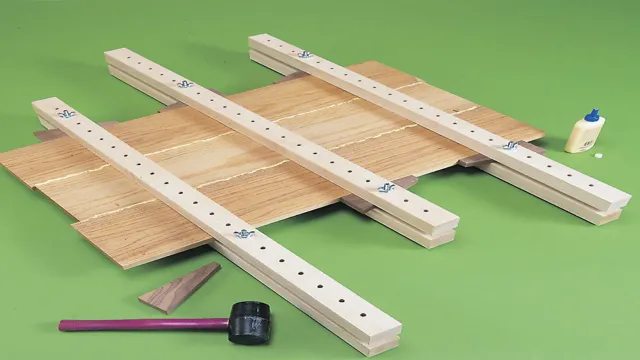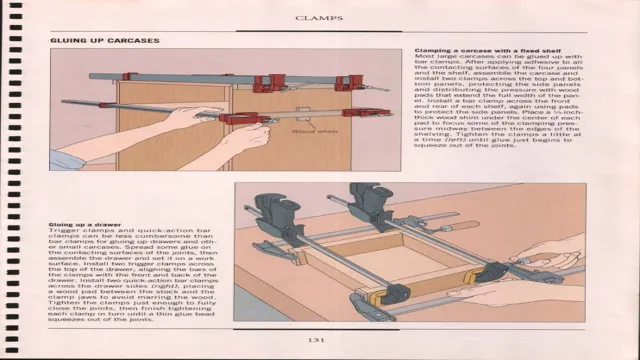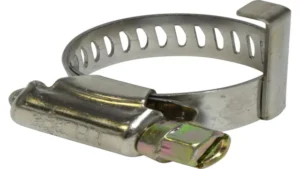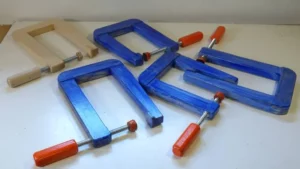Have you ever attempted a DIY woodworking project and found that your glue-up just wasn’t holding together? It’s frustrating and can lead to a lot of wasted time and materials. But fear not, because with the right clamps, you can achieve a successful glue-up every time. Clamps are an essential tool in any woodworking project.
They are the secret to evenly distributing pressure and ensuring a strong bond between your pieces. Different projects require different types of clamps, so it’s important to know what you need before you get started. For smaller projects, such as boxes or picture frames, bar clamps or quick-release clamps may be all you need.
But for larger projects, you’ll want to invest in heavy-duty parallel clamps or pipe clamps. These clamps provide the necessary pressure to hold large pieces together, ensuring a tight fit. It’s also important to consider the size and shape of your project when choosing clamps.
You may need corner clamps for square or rectangle-shaped pieces, or you may need specialty clamps for unique shapes. In short, the right clamps are essential for a successful glue-up. Don’t let a weak bond ruin your woodworking project – invest in the right clamps for the job and guarantee a strong hold every time.
Understanding Clamps for Glue Up
When it comes to glue ups, one of the most important considerations is how many clamps are needed to ensure a strong bond. Generally, the rule of thumb is to use one clamp for every foot of surface area being glued. However, there are other factors that can come into play as well.
For instance, if the wood being glued is particularly heavy or prone to warping, more clamps may be needed to hold it securely in place. Additionally, the type of glue being used can affect the number of clamps needed. Some glues require more pressure than others to achieve a good bond, and may therefore require more clamps.
Ultimately, the best approach is to carefully assess the specific project at hand and make decisions based on factors such as the size and weight of the wood, the type of glue being used, and the application method. By taking the time to carefully plan a glue up and select the right number of clamps, you can ensure a strong, long-lasting bond that will stand up to the demands of regular use.
Types of Clamps and Their Uses
Clamps are essential tools for glue up woodworking projects. They come in different types, including the bar clamp, pipe clamp, and parallel-jaw clamp. The bar clamp is an all-purpose tool with slide bars, and it is the most common type.
The pipe clamp uses a pipe as the bar to increase its span and clamp pressure. The parallel-jaw clamp is ideal for use on cabinets, panels, and drawers. It has a mechanism that provides even pressure throughout the jaws.
The type of clamp that’s best for your project depends on the job at hand. Some clamps are great for bigger projects, while others are ideal for small jobs. Understanding the uses of different clamps is essential, especially if you’re new to woodworking.
Clamps ensure that your project is held securely together and that the glue dries correctly. Without them, your project would fall apart. So, it’s essential to choose the right clamp for your job to ensure a sturdy and long-lasting finished product.

Factors to Consider for Choosing Clamps
When it comes to woodworking, clamps are an essential tool for glue up. But with so many options available, it can be overwhelming to know which ones to choose. One factor to consider is the type of material you’ll be clamping.
Woodworkers often prefer wooden clamps, as they won’t damage the wood like metal ones might. Another consideration is the size and shape of the pieces you’re working with. If you’re working with large pieces, you’ll need clamps with a long reach.
Bar clamps or pipe clamps are great choices for larger projects. Additionally, the type of glue you’ll be using can affect your clamp choice. For example, if you’re using a slow-drying glue, you’ll need clamps that will hold the pieces in place for longer.
All of these factors are important to consider when choosing the right clamps for your glue up project.
Determining How Many Clamps You Need
When it comes to glue-ups, having the right amount of clamps can make all the difference. The number of clamps you’ll need ultimately depends on the size and complexity of the project you’re working on. A good rule of thumb is to have at least one clamp for every six inches of surface area being glued, but this can vary.
If you’re working with large boards or multiple pieces that need to be joined, you’ll likely need more clamps to ensure a strong bond. It’s also important to consider the type and quality of the clamps you’re using – cheaper or weaker clamps may require more to achieve the same result as a stronger clamp. So, before you get started on your glue-up, take some time to consider the surface area you’re working with and the strength of your clamps to determine how many you’ll need for a successful project.
Calculating Clamp Spacing
Clamp Spacing When setting up a woodworking project, it’s important to ensure that the pieces being joined are held tightly in place during the glue-drying process. This is where clamps come in. But how do you determine how many you need and how far apart to space them? Firstly, start by calculating the total linear footage of the pieces being joined.
A good rule of thumb is to use one clamp for every 12 inches of linear footage. However, if the pieces being joined are particularly large, you may want to space them closer together to ensure even pressure across the entire surface. It’s also worth considering the type and size of the clamp being used, as some may require more spacing than others.
Taking the time to calculate clamp spacing may seem like a minor detail, but it can make all the difference in achieving a seamless, strong joint in your woodworking project.
Calculating Number of Clamps Needed
When it comes to determining the number of clamps needed for your project, there are a few factors to consider. Firstly, the size and thickness of the materials you will be clamping together will play a role in determining how many clamps are needed. It’s important to ensure that the clamps you choose are strong enough to firmly hold the materials in place.
Another factor to consider is the size of your workspace and the number of clamping areas you have available. If you have limited workspace, you may need to carefully plan how you position your materials to ensure efficient use of your clamps. Finally, it’s a good idea to have a few extra clamps on hand just in case, as having a backup can save time and frustration if something doesn’t go as planned.
By considering these factors and planning accordingly, you can ensure that you have the right number of clamps to successfully complete your project.
Conclusion
In the world of woodworking, the number of clamps needed for glue up is like the number of toppings on a pizza – there’s no one right answer, it all depends on personal preference and the project at hand. So go ahead and experiment with different clamp quantities, and may your glue-ups be steady and strong, like the foundation of a good pizza crust!”
FAQs
What is the recommended number of clamps for a glue up?
It depends on the size and complexity of the project, but a general rule of thumb is to use one clamp per foot of material.
Can I use too many clamps for a glue up?
Yes, using too many clamps can actually cause uneven pressure and result in a weaker bond. Use the recommended number of clamps for the size of your project.
Do I need special clamps for a glue up?
No, standard woodworking clamps will work for most glue ups. However, some projects may require specialized clamps, like pipe clamps or strap clamps.
How long should I leave the clamps on after a glue up?
The length of time will depend on the type of glue used, but as a general rule, clamps should be left on for at least 30 minutes to an hour before removing.
Can I reuse the same clamps for multiple glue ups?
Yes, as long as the clamps are in good condition and still provide even pressure. However, it’s important to clean them thoroughly between uses to prevent glue buildup.
How tight should I tighten the clamps for a glue up?
The clamps should be tight enough to provide even pressure, but not so tight as to crush the wood fibers. Use your best judgment and adjust as needed.
What if I don’t have enough clamps for my project?
You can stagger the placement of your clamps, or use a bracing method to provide additional pressure. You can also glue up smaller sections and then join them together later.






